前言:
项目地址:https://gitee.com/whltaoin_admin/hmtt_cloud-project.git
阶段七进度版本号:9b24cde9db94dcec59f1245a38c9408a750120c5
获取redis中的需要的key值
方法一:使用命令:key*
java
@Test
public void getKeyTest(){
// 方法一
Set<String> keys = cacheService.keys("future_*");
System.out.println(keys);
}
}方法二:使用scan命令
java
@Test
public void getKeyTest(){
// 方法二:
Set<String> scan = cacheService.scan("future_*");
System.out.println(scan);
}
}效果
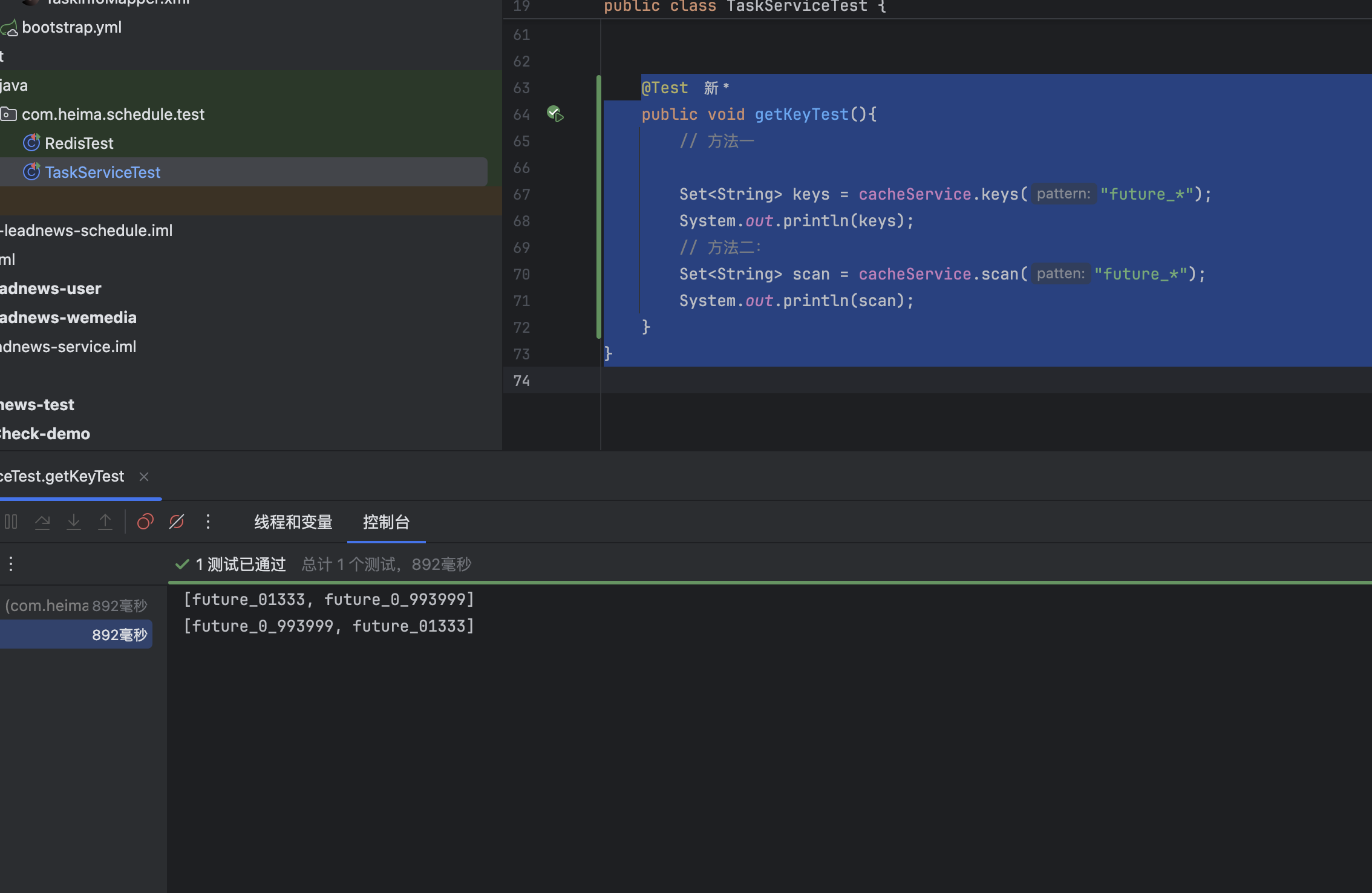
选择
方案一:key
keys的模糊匹配功能很方便,模糊匹配却发现redis的CPU使用率极高,redis是单线程,会被堵塞
方案2:scan
SCAN 命令是一个基于游标的迭代器,SCAN命令每次被调用之后, 都会向用户返回一个新的游标, 用户在下次迭代时需要使用这个新游标作为SCAN命令的游标参数, 以此来延续之前的迭代过程。
reids管道
对比
- 普通客户端
- 需要来回的发送和接收,耗时长
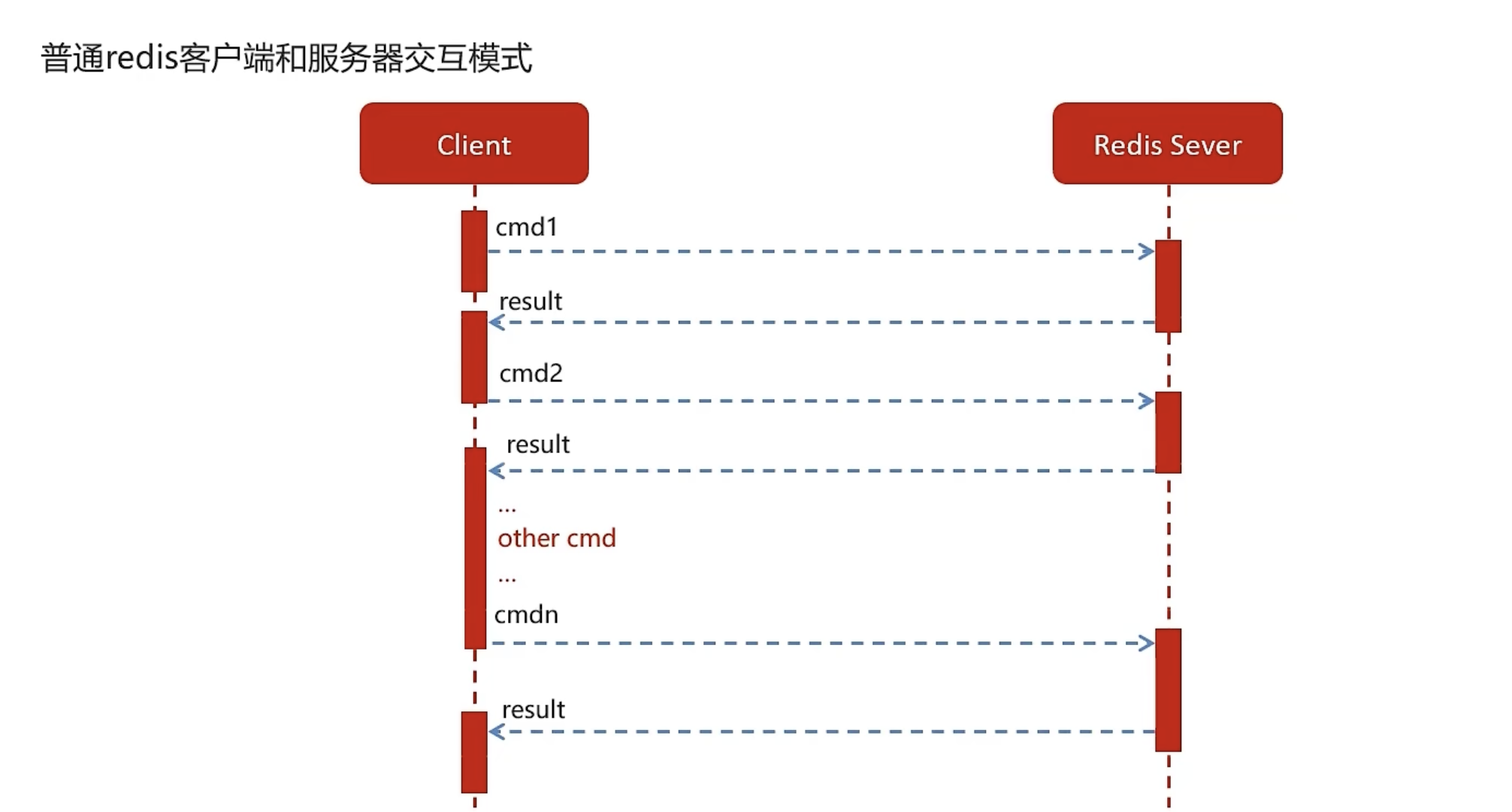
- reids管道
- 将任务都先放入管道中,一起执行完毕后,一起返回。
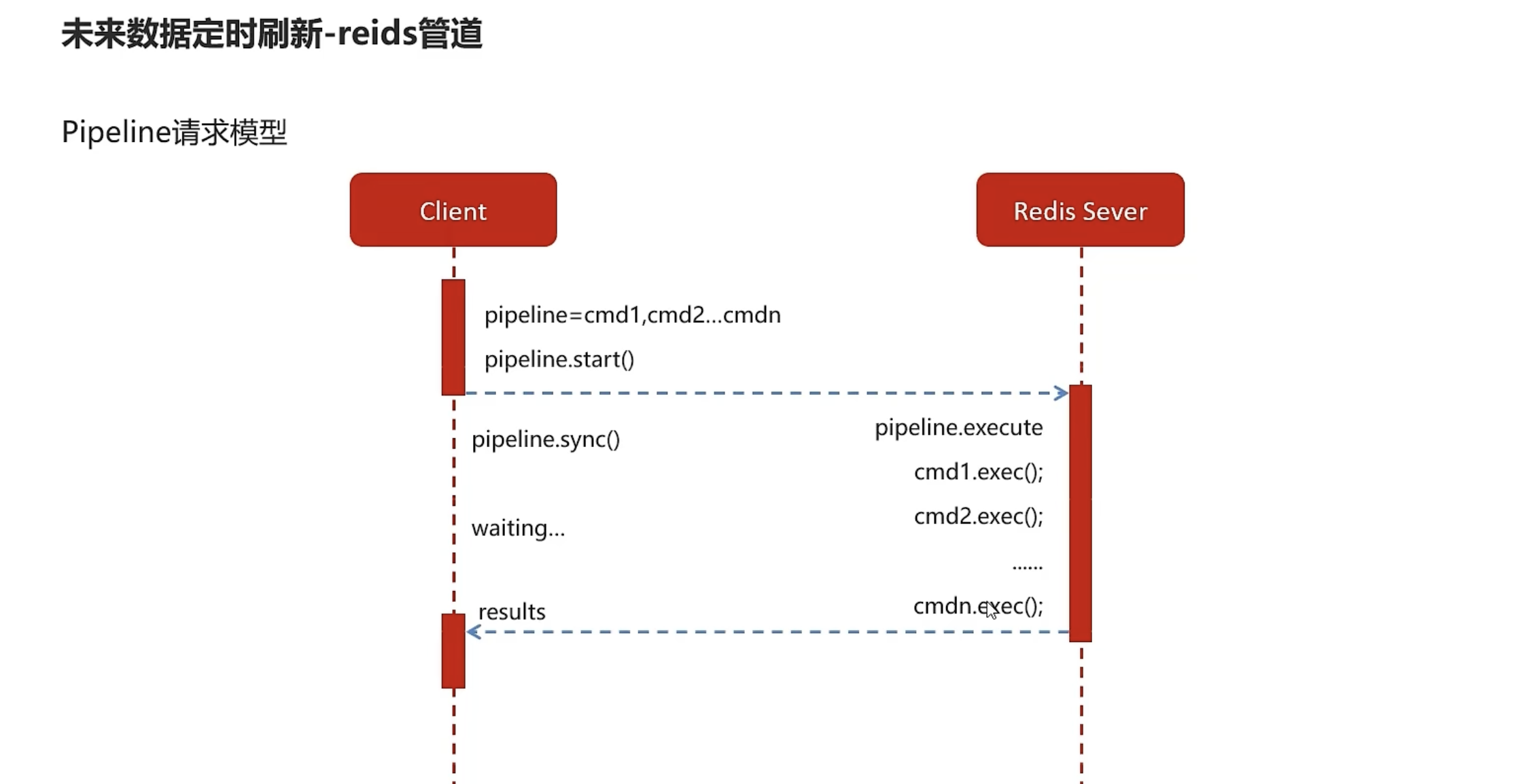
示例
- 普通
java
//耗时
@Test
public void testPiple1(){
long start =System.currentTimeMillis();
for (int i = 0; i <100 ; i++) {
Task task = new Task();
task.setTaskType(101);
task.setPriority(1);
task.setExecuteTime(new Date().getTime());
cacheService.lLeftPush("101_1", JSON.toJSONString(task));
}
System.out.println("耗时"+(System.currentTimeMillis()- start));
}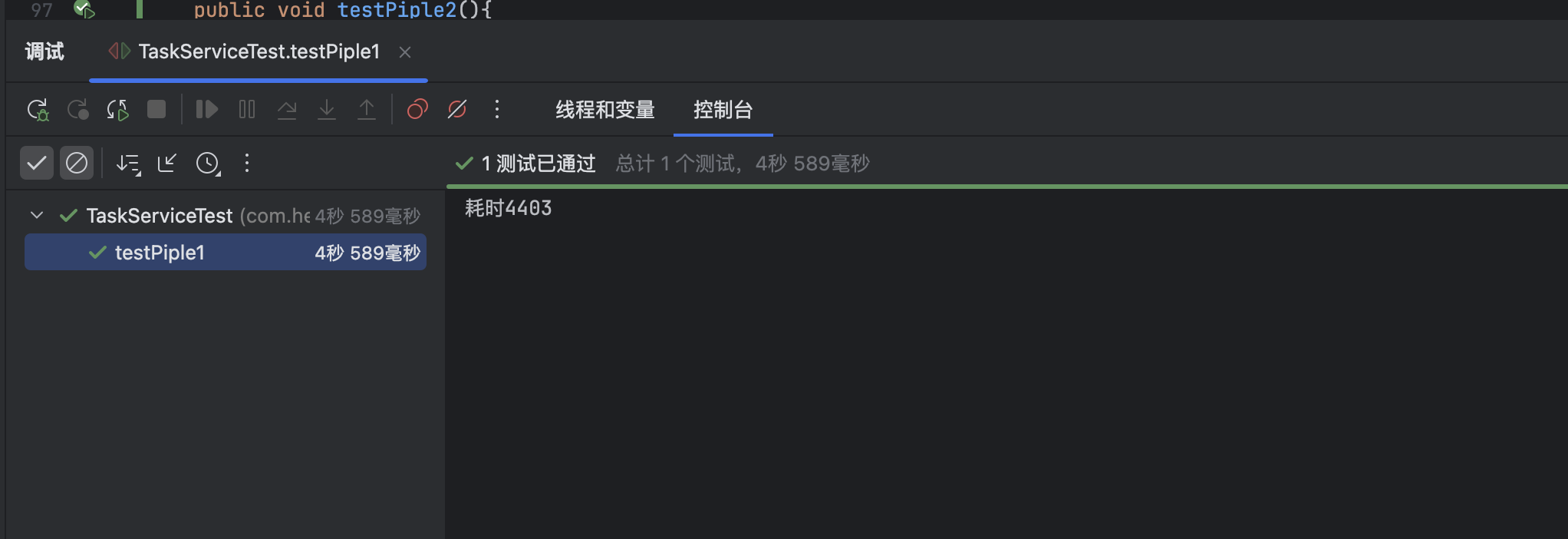
- 管道
java
@Test
public void testPiple2(){
long start = System.currentTimeMillis();
//使用管道技术
List<Object> objectList = cacheService.getstringRedisTemplate().executePipelined(new RedisCallback<Object>() {
@Nullable
@Override
public Object doInRedis(RedisConnection redisConnection) throws DataAccessException {
for (int i = 0; i <100 ; i++) {
Task task = new Task();
task.setTaskType(101);
task.setPriority(1);
task.setExecuteTime(new Date().getTime());
redisConnection.lPush("101_1".getBytes(), JSON.toJSONString(task).getBytes());
}
return null;
}
});
System.out.println("使用管道技术执行100次自增操作共耗时:"+(System.currentTimeMillis()-start)+"毫秒");
}
未来数据定时刷新
流程
- 创建一个每分钟刷新一次的方法
- 使用scan方法查询到未来数据所有的key
- 通过优先级和执行时间判断出,当前需要执行的数据
- 放入到list中并删除zset中的数据
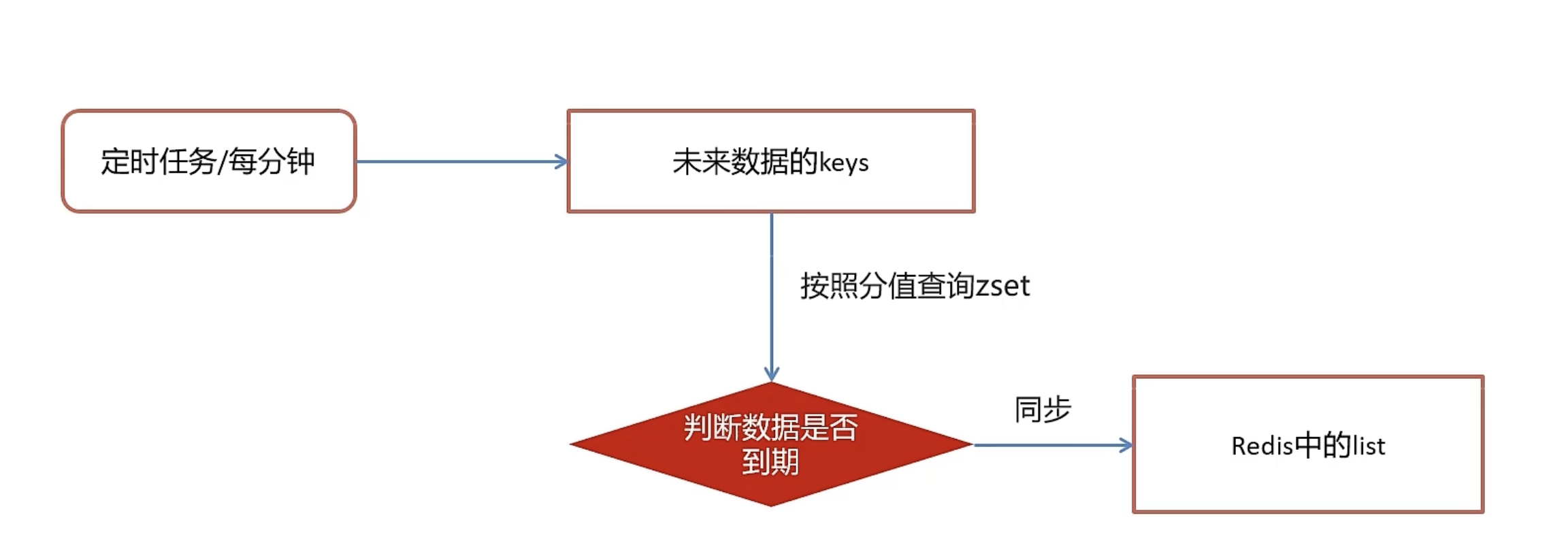
实现
- 方法
java
/**
* 未来任务定时刷新
*/
@Scheduled(cron = "0 */1 * * * ?")
public void futureTaskRefresh(){
System.out.println(System.currentTimeMillis() / 1000 + "执行了定时任务");
// 2. 使用scan方法查询到未来数据所有的key
Set<String> scan = cacheService.scan(ScheduleConstants.FUTURE + "*");
scan.forEach(s->{
String topicKey = ScheduleConstants.TOPIC + s.split(ScheduleConstants.FUTURE)[1];
// 3. 通过优先级和执行时间判断出,当前需要执行的数据
Set<String> tasks = cacheService.zRangeByScore(s, 0, System.currentTimeMillis());
if (!tasks.isEmpty()) {
// 4. 放入到list中并删除zset中的数据
cacheService.refreshWithPipeline(s,topicKey,tasks);
System.out.println("成功的将" + topicKey + "下的当前需要执行的任务数据刷新到" + topicKey + "下");
}
});
}- 在启动类上添加Scheduling注解
测试
- 执行测试方法
java
@Test
public void addFutureTask(){
for (int i = 0; i < 20; i++) {
Task task = new Task();
task.setParameters("varin varin varintest".getBytes());
task.setTaskType(i);
// Calendar calendar = Calendar.getInstance();
// calendar.add(Calendar.MINUTE,3);
task.setExecuteTime(System.currentTimeMillis()+500+i);
task.setPriority(1);
taskService.addTask(task);
}
}- 启动模块
- 效果
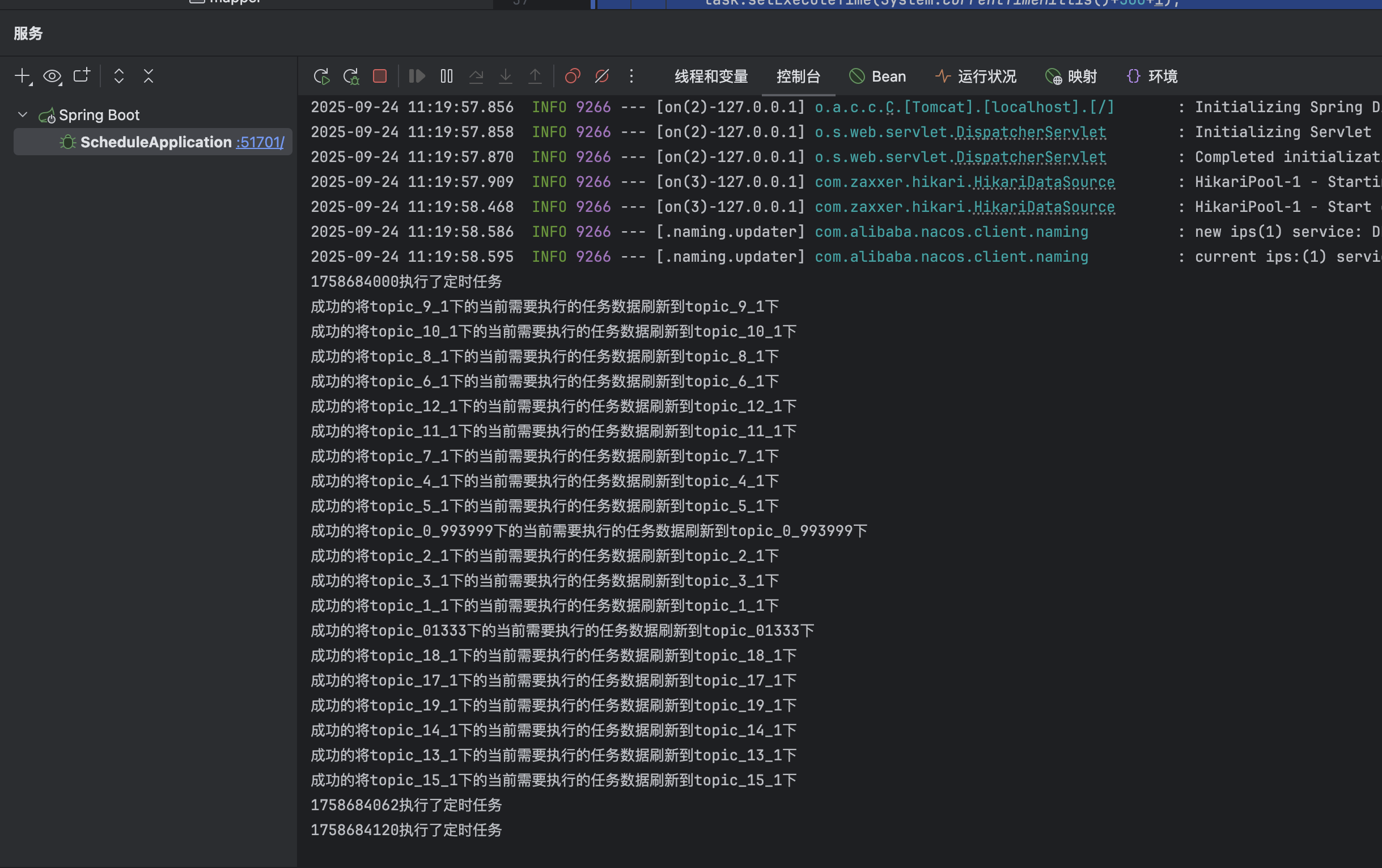
分布式锁解决集群下的定时任务抢占执行
分析需求
当同时启动存在定时任务的服务时,两个服务都会执行定时任务,可能会出现系统异常的情况
技术选择

使用redis中的setnx实现分布式锁
sexnx (SET if Not eXists) 命令在指定的 key 不存在时,为 key 设置指定的值。
这种加锁的思路是,如果 key 不存在则为 key 设置 value,如果 key 已存在则 SETNX 命令不做任何操作
- 客户端A请求服务器设置key的值,如果设置成功就表示加锁成功
- 客户端B也去请求服务器设置key的值,如果返回失败,那么就代表加锁失败
- 客户端A执行代码完成,删除锁
- 客户端B在等待一段时间后再去请求设置key的值,设置成功
- 客户端B执行代码完成,删除锁
- 实现方法
java
/**
* 加锁
*
* @param name
* @param expire
* @return
*/
public String tryLock(String name, long expire) {
name = name + "_lock";
String token = UUID.randomUUID().toString();
RedisConnectionFactory factory = stringRedisTemplate.getConnectionFactory();
RedisConnection conn = factory.getConnection();
try {
//参考redis命令:
//set key value [EX seconds] [PX milliseconds] [NX|XX]
Boolean result = conn.set(
name.getBytes(),
token.getBytes(),
Expiration.from(expire, TimeUnit.MILLISECONDS),
RedisStringCommands.SetOption.SET_IF_ABSENT //NX
);
if (result != null && result)
return token;
} finally {
RedisConnectionUtils.releaseConnection(conn, factory,false);
}
return null;
}- 定时任务加锁
java
/**
* 未来任务定时刷新
*/
@Scheduled(cron = "0 */1 * * * ?")
public void futureTaskRefresh(){
String token = cacheService.tryLock("FUTURE_TASK_SYNC", 1000 * 30);
if (!StringUtils.isNotBlank(token)) {
return;
}
Date now = new Date(System.currentTimeMillis());
System.out.println(now.toString() + "执行了定时任务");
// 2. 使用scan方法查询到未来数据所有的key
Set<String> scan = cacheService.scan(ScheduleConstants.FUTURE + "*");
scan.forEach(s->{
String topicKey = ScheduleConstants.TOPIC + s.split(ScheduleConstants.FUTURE)[1];
// 3. 通过优先级和执行时间判断出,当前需要执行的数据
Set<String> tasks = cacheService.zRangeByScore(s, 0, System.currentTimeMillis());
if (!tasks.isEmpty()) {
// 4. 放入到list中并删除zset中的数据
cacheService.refreshWithPipeline(s,topicKey,tasks);
System.out.println("成功的将" + topicKey + "下的当前需要执行的任务数据刷新到" + topicKey + "下");
}
});
}将数据库中的任务同步到redis中
流程
删除redis中两个主题的任务
重新判断符合条件的数据到redis中
设置服务启动的时候,立即执行,之后5分钟执行一次
实现
java
/**
* 数据库任务同步到redis
*
*/
@PostConstruct
@Scheduled(cron = "0 */5 * * * *")
public void reloadData(){
// 1. 删除redis中两个主题的任务
clearRedis();
// 2. 重新判断符合条件的数据到redis中
Calendar calendar = Calendar.getInstance();
calendar.add(Calendar.MINUTE,5);
List<Taskinfo> taskinfos = taskinfoMapper.selectList(Wrappers.<Taskinfo>lambdaQuery().le(Taskinfo::getExecuteTime, calendar.getTime()));
// 判断是否有数据
if (taskinfos!=null && taskinfos.size()>0) {
taskinfos.forEach(taskinfo->{
Task task = new Task();
BeanUtils.copyProperties(taskinfo,task);
task.setExecuteTime(taskinfo.getExecuteTime().getTime());
addTasktoCache(task);
});
}
log.info("数据库中的数据被同步到了redis中");
}
// 清除reids中的数据
public void clearRedis(){
Set<String> topicKeys = cacheService.scan(ScheduleConstants.TOPIC + "*");
Set<String> futureKeys = cacheService.scan(ScheduleConstants.FUTURE + "*");
cacheService.delete(topicKeys);
cacheService.delete(futureKeys);
}
Feign服务实现schedule客户端
- 在feign创建IScheduleClient类
java
package cn.varin.apis.article.cn.varin.apis.schedule;
import com.heima.model.common.dtos.ResponseResult;
import com.heima.model.schedule.dtos.Task;
import org.springframework.cloud.openfeign.FeignClient;
import org.springframework.web.bind.annotation.GetMapping;
import org.springframework.web.bind.annotation.PathVariable;
import org.springframework.web.bind.annotation.PostMapping;
import org.springframework.web.bind.annotation.RequestBody;
@FeignClient(value = "leadnews-schedule")
public interface IScheduleClient {
/**
*
* @param task
* @return
*/
@PostMapping("/api/v1/task/add")
ResponseResult addTask( @RequestBody Task task);
@GetMapping("/api/v1/task/{taskId}")
ResponseResult cancelTask(@PathVariable("taskId") Long taskId);
@GetMapping("/api/v1/task/{taskType}/{priority}")
ResponseResult pull(@PathVariable("taskType")Integer taskType,@PathVariable("priority")Integer priority);
}- 在schedule模块中创建ScheduleClient实现IScheduleClient
java
package com.heima.schedule.feign;
import cn.varin.apis.article.cn.varin.apis.schedule.IScheduleClient;
import com.heima.model.common.dtos.ResponseResult;
import com.heima.model.schedule.dtos.Task;
import com.heima.schedule.service.TaskService;
import org.springframework.beans.factory.annotation.Autowired;
import org.springframework.web.bind.annotation.*;
@RestController
public class ScheduleClient implements IScheduleClient {
@Autowired
private TaskService taskService;
@PostMapping("/api/v1/task/add")
public ResponseResult addTask( @RequestBody Task task){
return ResponseResult.okResult(taskService.addTask(task));
}
@GetMapping("/api/v1/task/{taskId}")
public ResponseResult cancelTask(@PathVariable("taskId") Long taskId) {
return ResponseResult.okResult(taskService.cancelTask(taskId));
}
@GetMapping("/api/v1/task/{taskType}/{priority}")
public ResponseResult pull(@PathVariable("taskType")Integer taskType,@PathVariable("priority")Integer priority){
return ResponseResult.okResult(taskService.pull(taskType,priority));
}
}文章发布后将其添加到延迟队列中
流程:
- 在自媒体端,添加文章点击发布后,调用添加延迟队列方法,
- 根据不同的发布时间,存储成为不同的任务类型

实现
- 在自媒体端的service模块中加入新的接口:WmNewsTaskService
java
package com.heima.wemedia.service;
import java.util.Date;
public interface WmNewsTaskService {
/**
* 添加任务到队列中
*/
void addNewsToTask(Integer id, Date publishTime);
}- 实现接口:
java
package com.heima.wemedia.service.impl;
import cn.varin.apis.article.cn.varin.apis.schedule.IScheduleClient;
import com.heima.model.common.enums.TaskTypeEnum;
import com.heima.model.schedule.dtos.Task;
import com.heima.model.wemedia.pojos.WmNews;
import com.heima.utils.common.ProtostuffUtil;
import com.heima.wemedia.service.WmNewsTaskService;
import lombok.extern.slf4j.Slf4j;
import org.checkerframework.checker.index.qual.SameLen;
import org.springframework.beans.factory.annotation.Autowired;
import org.springframework.scheduling.annotation.Async;
import org.springframework.stereotype.Service;
import org.springframework.transaction.annotation.Transactional;
import java.util.Date;
@Service
@Slf4j
public class WmNewsTaskServiceImpl implements WmNewsTaskService {
@Autowired
private IScheduleClient scheduleClient;
@Override
@Async
public void addNewsToTask(Integer id, Date publishTime) {
log.info("添加任务到延迟服务中----begin");
System.out.println(publishTime);
Task task = new Task();
task.setExecuteTime(publishTime.getTime());
task.setTaskType(TaskTypeEnum.NEWS_SCAN_TIME.getTaskType());
task.setPriority(TaskTypeEnum.NEWS_SCAN_TIME.getPriority());
WmNews wmNews = new WmNews();
wmNews.setId(id);
task.setParameters(ProtostuffUtil.serialize(wmNews));
scheduleClient.addTask(task);
log.info("添加任务到延迟服务中----end");
}
}- 添加序列化工具类
- 依赖
xml
<dependency>
<groupId>io.protostuff</groupId>
<artifactId>protostuff-core</artifactId>
<version>1.6.0</version>
</dependency>
<dependency>
<groupId>io.protostuff</groupId>
<artifactId>protostuff-runtime</artifactId>
<version>1.6.0</version>
</dependency>2. 工具类1:JdkSerializeUtil
java
package com.heima.utils.common;
import java.io.ByteArrayInputStream;
import java.io.ByteArrayOutputStream;
import java.io.ObjectInputStream;
import java.io.ObjectOutputStream;
/**
* jdk序列化
*/
public class JdkSerializeUtil {
/**
* 序列化
* @param obj
* @param <T>
* @return
*/
public static <T> byte[] serialize(T obj) {
if (obj == null){
throw new NullPointerException();
}
ByteArrayOutputStream bos = new ByteArrayOutputStream();
try {
ObjectOutputStream oos = new ObjectOutputStream(bos);
oos.writeObject(obj);
return bos.toByteArray();
} catch (Exception ex) {
ex.printStackTrace();
}
return new byte[0];
}
/**
* 反序列化
* @param data
* @param clazz
* @param <T>
* @return
*/
public static <T> T deserialize(byte[] data, Class<T> clazz) {
ByteArrayInputStream bis = new ByteArrayInputStream(data);
try {
ObjectInputStream ois = new ObjectInputStream(bis);
T obj = (T)ois.readObject();
return obj;
} catch (Exception ex) {
ex.printStackTrace();
}
return null;
}
}3. 工具类2:ProtostuffUtil
java
package com.heima.utils.common;
import com.heima.model.wemedia.pojos.WmNews;
import io.protostuff.LinkedBuffer;
import io.protostuff.ProtostuffIOUtil;
import io.protostuff.Schema;
import io.protostuff.runtime.RuntimeSchema;
public class ProtostuffUtil {
/**
* 序列化
* @param t
* @param <T>
* @return
*/
public static <T> byte[] serialize(T t){
Schema schema = RuntimeSchema.getSchema(t.getClass());
return ProtostuffIOUtil.toByteArray(t,schema,
LinkedBuffer.allocate(LinkedBuffer.DEFAULT_BUFFER_SIZE));
}
/**
* 反序列化
* @param bytes
* @param c
* @param <T>
* @return
*/
public static <T> T deserialize(byte []bytes,Class<T> c) {
T t = null;
try {
t = c.newInstance();
Schema schema = RuntimeSchema.getSchema(t.getClass());
ProtostuffIOUtil.mergeFrom(bytes,t,schema);
} catch (InstantiationException e) {
e.printStackTrace();
} catch (IllegalAccessException e) {
e.printStackTrace();
}
return t;
}
/**
* jdk序列化与protostuff序列化对比
* @param args
*/
public static void main(String[] args) {
long start =System.currentTimeMillis();
for (int i = 0; i <1000000 ; i++) {
WmNews wmNews =new WmNews();
JdkSerializeUtil.serialize(wmNews);
}
System.out.println(" jdk 花费 "+(System.currentTimeMillis()-start));
start =System.currentTimeMillis();
for (int i = 0; i <1000000 ; i++) {
WmNews wmNews =new WmNews();
ProtostuffUtil.serialize(wmNews);
}
System.out.println(" protostuff 花费 "+(System.currentTimeMillis()-start));
}
}- 调用方法
java
public ResponseResult submit(WmNewsDto dto) {
// // 条件判断dot是否为null或者dto中的内容是否为null
if (dto==null || dto.getContent()==null) {
// 返回提示无效参数
return ResponseResult.errorResult(AppHttpCodeEnum.PARAM_INVALID);
}
// 1保存或修改文章
WmNews wmNews = new WmNews();
BeanUtils.copyProperties(dto,wmNews);
// 判断是否存储图片
if (dto.getImages()!=null && dto.getImages().size()>0) {
String join = StringUtils.join(",", dto.getImages());
wmNews.setImages(join);
}
if (dto.getType().equals(WemediaConstants.WM_NEWS_TYPE_AUTO)) {
wmNews.setType(null);
}
saveOrUpdateWmNews(wmNews);
// 2 判断是否为草稿,如果是草稿结束方法
if (dto.getStatus().equals(WmNews.Status.NORMAL.getCode())) {
// 成功返回
return ResponseResult.okResult(AppHttpCodeEnum.SUCCESS);
}
// 3 不是草稿,保存文章内容图片和素材的关系
// 从json中取出图片列表
List<String> imageList= getContentImage(dto.getContent());
// 保存文件和图片的关系
saveContentImage(imageList,wmNews.getId());
// 4 不是草稿,保存嗯栈封面图片和素材的关系
saveMaterialForCover(dto,wmNews,imageList);
// 发布后开始审核
// wmNewAutoScanService.AutoScanWmNews(wmNews.getId());
// 发布的任务添加到队列
wmNewsTaskService.addNewsToTask(wmNews.getId(),wmNews.getPublishTime());
return ResponseResult.okResult(AppHttpCodeEnum.SUCCESS);
}定时拉取任务并进行审核
- 思路:
- 通过之前定义的pull方法,会将redis中时间到了的任务拉取下来
- 拉取的data中存储task类型的json字符串
- 先将其转为task对象
- 在从task的属性:getParameters
- 反序列化出WmNews
最后将其传递给自动审核的方法
- 实现:
java
@Scheduled(fixedRate = 1000)//一秒一次
@Override
public void scanNewsToTask() {
ResponseResult result = scheduleClient.pull(TaskTypeEnum.NEWS_SCAN_TIME.getTaskType(), TaskTypeEnum.NEWS_SCAN_TIME.getPriority());
log.info("文章审核---消费任务执行---start---");
if (result.getCode().equals(200) && result.getData()!=null) {
// 解析JSON为Task对象
String jsonString = JSON.toJSONString(result.getData());
Task task = JSON.parseObject(jsonString, Task.class);
// 反序列化
WmNews nwe = ProtostuffUtil.deserialize(task.getParameters(), WmNews.class);
// 自动审核
wmNewAutoScanService.AutoScanWmNews(nwe.getId());
}
log.info("文章审核---消费任务执行---end---");
}加油呀!